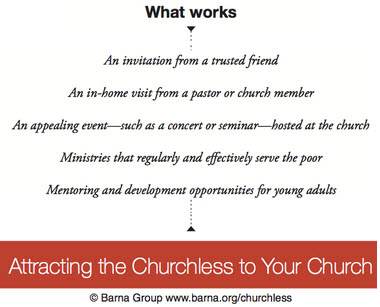 Long ago I stopped counting how many times people have asked me what they need to do to help their congregation grow. Thankfully most who ask this of me are not primarily interested in transfer growth (sometimes called “sheep stealing” or more nicely redistribution) that comes when churched people choose to shift their allegiance from their current faith community to a new one. Most of my questioners are genuinely interested in helping their church welcome new people who are currently not connected to any churches or religious communities.
Long ago I stopped counting how many times people have asked me what they need to do to help their congregation grow. Thankfully most who ask this of me are not primarily interested in transfer growth (sometimes called “sheep stealing” or more nicely redistribution) that comes when churched people choose to shift their allegiance from their current faith community to a new one. Most of my questioners are genuinely interested in helping their church welcome new people who are currently not connected to any churches or religious communities.
Fastest Growing Group
A few weeks ago I wrote about the rise is churchlessness in America. In that post I mentioned that the de-churched (those once connected to a church who have severed that tie) are now the fastest growing group, and comprise 1 out of every 3 Americans. This is the group that most should try to reach. While some within the de-churched are likely now “dones” (more on this newly named group), many have not written off the possibility of connecting again.
Futile or Worthwhile?
According to Churchless: Understanding Today’s Unchurched and How to Connect with Them (2014) by the Barna Group (with George Barna and David Kinnaman as general editors) many of the efforts churches make to attract the churchless fall clearly in one of two categories: those that often work and those that rarely do (p.154).
|
What Works |
What Doesn’t |
| an invitation from a trusted friend | direct mail from the church |
| an in-home visit from a pastor or church member | tv, newspaper, billboard, or radio ads |
| an appealing event (concert or seminar) hosted at the church | unsolicited phone calls |
| ministries that regularly & effectively serve the poor | relying on the church website |
| mentoring & development opportunities for young adults | celebrity guest speakers in worship |
So What?
Currently, about 1 out of every 7 churchless adults in our country is open to trying a new church (p.155). While that number may seem low, it actually represents around 16 million people.
Some of the approaches that are more likely to be effective than others have changed over the years, but other approaches have remained helpful for a generation or more – including the highest-rated tactic of all: a personal invitation from a trusted friend (p.157). Other relational options also fared well, including a surprise: an in-home visit from a pastor or church member to discuss the possibility of attending church (1 of 6 would respond positively, p.157). Events, long seen as an easier entry point for those who have been out of church for awhile, are also of interest provided they are relevant and high quality (1 in 5 would consider attending, p.158).
Notably churchless adults are rarely attracted to a church based on its reputation for having excellent worship music or high quality sermons. Instead, the two most significant aspects of a congregation’s reputation likely to have a positive impact are (1) being known for regularly and effectively serving the poor and (2) being known as a church that understands young people and provides the kind of mentoring and development they need to be successful in life (p.158-9).
- One a scale of 1 to 10, how committed is your church to reaching unchurched people?
- What are the primary ways your church currently seeks to reach unchurched people? Share one great success and one significant failure.
- How does your church evaluate the relative success of each and how are those rates used in the planning process?